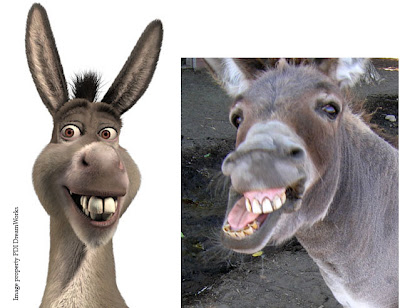
Monkeys, rats, mice, squirrels, rabbits, bears, and kangaroos all seem to have hands. And they seem to be comfortable on two legs, so it’s no wonder they’ve been so popular as characters in animation. Scrat, above left, is exaggerated but not very humanized; the photo at right is humanized but not exaggerated.
We’ve all seen dogs and tigers and elephants on their hind legs in the circus, so it’s not too hard to imagine them in a humanoid mode.
Horses and donkeys are much harder to humanize. Even though they make funny faces, their mouths are far from their eyes, they don’t have hands; and they don’t often walk on their back legs.

So it’s a real credit to the character designers and animators at DreamWorks that they created such a memorable character out of the Donkey. Besides endowing him with expressive eyebrows and giving the lips a lot of mobility, they used a lot of ear movement to show expression.
Prey animals tend to have their eyes on the sides of their heads. This presents a problem on a 3-D character where both eyes need to be visible from a lot of angles to show human-type emotions. So one of the first jobs of the designer is to bring the eyes forward. They also like to show some whites to the eyes so you can see where they’re looking, especially in a long shot.

In Ratatouille, the main rat characters shifted back and forth between humanlike and ratlike characteristics. When they were raiding the food cabinet, for example, they ran on all fours in a very ratlike way.
These are the kinds of challenges all animal character designers face. Which animal characteristics should you maintain and accentuate, and which human traits do you need to give the character--particularly a speaking character--so that he can think and act to win the sympathy of the audience?
In the next post we’ll take a further look at the sympathy that we humans inevitably feel for animal emotions and expressions.
Không có nhận xét nào:
Đăng nhận xét